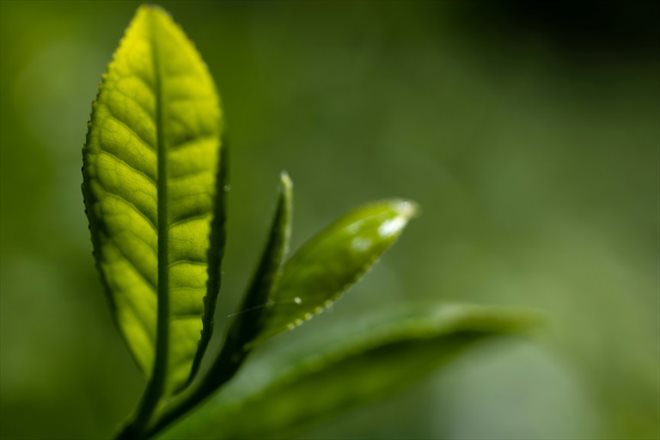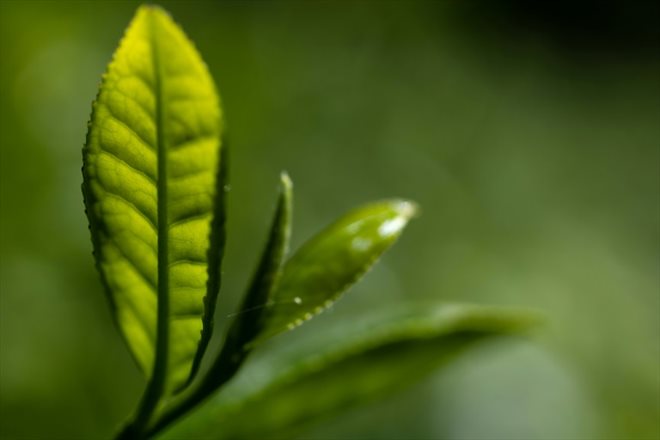Visitors pick tea leaves at the “Filleule des fées” plantation in Languidic, western France, August 9, 2023 (AFP/Fred TANNEAU)
The avenues of Camellias sinensis descend gently towards the steep valley of Blavet, in Languidic (Morbihan): quietly, like this pioneering “tea garden”, the “tea” sector begins to trace its furrow in Brittany and France.
Because Camellia sinensis, from the same family as the flowering camellia, is the Latin name for the tea plant, recalls Denis Mazerolle, founder, with his wife of Chinese origin Weizi, of one of the very first tea plantations in mainland France, “Goddaughter of the fairies.”
As for the garden camellia, very present in the region, “Brittany has everything for this culture”, underlines Céline Le Cras, head of cultivation in Languidic, “acidic soil, humidity and well-drained soil, in semi-shade. On the other hand, the tea plant does not like the wind. Hence the installation in this sheltered valley.
Passionate about tea for 40 years, the founding couple traveled across Asia to discover the regions “where tea is grown and made in an artisanal way” with the aim of taking inspiration from them to produce a “high quality organic tea “.

The owner of the “Filleule des fées” tea plantation, Denis Mazerolle, poses in Languidic, western France, August 9, 2023 (AFP/Fred TANNEAU)
Both had a long professional life away from Blavet before bringing their project to fruition. “Our first tea plants, from Georgia, were planted here in 2005 to see what it was like. The project came later, in 2016. And we have been marketing our tea for three years,” explains the tea grower who processes on site.
At the same time, other initiatives are appearing. Thus, in Morbihan, a horticultural high school was the first in France to offer an introduction to tea production to its students in 2020.
“The idea is to show young people a different production, to create an opening for them,” explains Marine Chotard, teacher at the Saint-Jean-Brévelay-Hennebont high school.

A cup of tea on a wooden log in the “Filleule des fées” tea plantation in Languidic, western France, August 9, 2023 (AFP/Fred TANNEAU)
The high school imported ten thousand plants from China in 2021 and established a partnership with a Chinese horticultural establishment.
“There is interest, including from the general public, in tea produced in France (…) Cosmetic companies are also showing their interest, in particular because of the antioxidant properties” of the tea plant, notes Marine Chotard. “We are really at the emergence of a sector,” she considers.
Except that the tea plant is a plant that requires patience: “it takes six or seven years for the tea plant to reach maturity”, indicates Denis Mazerolle, inexhaustible on this “very resilient” plant.
– Time and money –
“It’s exciting, but it’s long and the investments are heavy,” warns Christèle Burel, project manager in organic agriculture at the Chamber of Agriculture of Brittany. When we choose a variety, “we will know in seven years if it was the right one, not in six months like a market gardener!”

A visitor holds a bamboo basket containing dried tea leaves at the “Filleule des fées” plantation in Languidic, western France, August 9, 2023 (AFP/Fred TANNEAU)
For a hectare of tea plants, “you need to count between 45,000 and 70,000 euros, (…) more expensive than a hectare (of plants) of vines”, assesses Alain Schlesser, young retiree and trained agronomist, who is launching cautiously in this culture in Cast (Finistère) after bringing back his first tea plants from China in 2003. “Until now, for years, I had fun making my little decoctions,” he quips.
Ms. Burel supports around ten “neo-tea growers”, often people who “already produce something else, like aromatic plants, and are looking to diversify”. “As soon as there is something new, it attracts, and those who do best are the first,” she says.
“I encourage them to produce organically (…), rather on premium.” As a Chamber, “we want to consolidate” the model before pushing for its development.

Tea leaves in the “Filleule des fées” plantation in Languidic, western France, August 9, 2023 (AFP/Fred TANNEAU)
Around “twenty projects” are in development in France, particularly in the Basque Country, estimates Denis Mazerolle.
A French association and a European one were created in order to facilitate the structuring of the sector but also its recognition by institutions. In addition to sharing knowledge, one of the objectives is to obtain labeling, such as Protected Designation of Origin (PDO).
In fact, tea growing could have started two centuries earlier in Brittany: forgotten, the first plantations in Nantes and Trévarez (Finistère) date from the middle of the 18th century.
© 2023 AFP
Did you like this article ? Share it with your friends using the buttons below.




